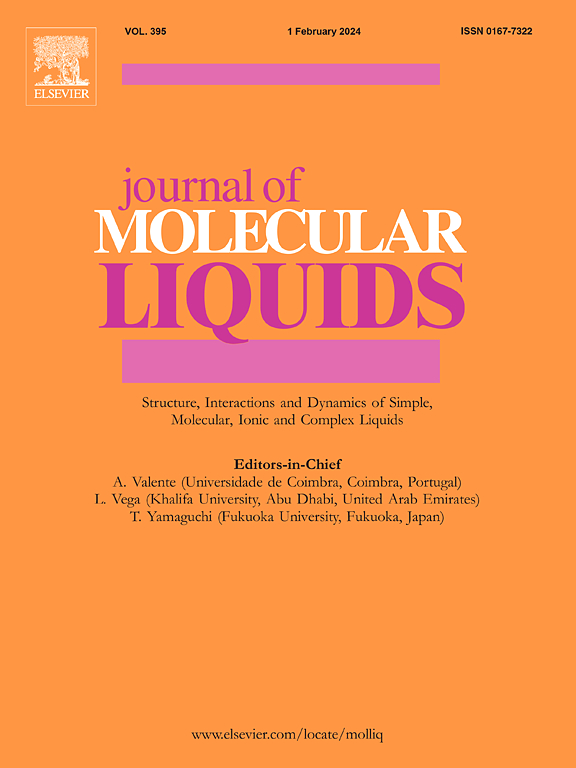坦索罗辛-水相互作用和水溶液中的电子吸收:来自第一性原理分子动力学的见解
IF 5.3
2区 化学
Q2 CHEMISTRY, PHYSICAL
引用次数: 0
摘要
了解生物相关分子物种与水之间的相互作用对于药物设计和评估其对生物体和环境的影响至关重要。在这项研究中,我们研究了坦索罗辛(TAMS)在水溶液中的分子行为,重点研究了它的动力学、与水的相互作用和电子吸收特性。磺胺-水相互作用能比水-水相互作用强,这突出了TAMS的两亲性。结构分析,包括径向分布函数和配位数,证实了TAMS主要是通过其亲水性磺胺基的相互作用在水中稳定的。本研究的另一个关键方面是TAMS在水中的电子吸收光谱,这对于理解其光降解作用起着至关重要的作用,这是其作为α受体阻滞剂在药物应用中的一个重要因素。TAMS吸收光谱的实验研究往往表现出对浓度和热力学条件等变量的强烈依赖,使确定结论复杂化。理论计算也存在挑战,最好通过第一原理方法来解决。本文采用时间依赖密度泛函理论(TD-DFT)研究了TAMS在水溶液中的电子吸收光谱。通过调整LC-ωPBE的ω参数,使其与苯酚的CASPT2激发能相匹配,得到了准确的描述。计算谱与最近的实验数据吻合良好。此外,半经验ZINDO/S方法尽管计算成本较低,但可以捕获水中TAMS的关键光谱特征。本文章由计算机程序翻译,如有差异,请以英文原文为准。
Tamsulosin–water interactions and electronic absorption in aqueous solution: Insights from first-principles molecular dynamics
Understanding the interactions between biologically relevant molecular species and water is crucial for drug design and assessing their impact on living organisms and the environment. In this study, we investigate the molecular behavior of tamsulosin (TAMS) in aqueous solution, focusing on its dynamics, interactions with water, and electronic absorption properties.
The amphiphilic nature of TAMS is highlighted by its sulfonamide–water interaction energy, which is predicted to be stronger than water–water interactions. Structural analyses, including radial distribution functions and coordination numbers, confirm that TAMS is primarily stabilized in water through interactions involving its hydrophilic sulfonamide group.
Another key aspect of this study is the electronic absorption spectrum of TAMS in water, which plays a crucial role in understanding its photodegradation—an important factor in its pharmaceutical application as an alpha-blocker. Experimental studies on TAMS absorption spectra often exhibit strong dependence on variables such as concentration and thermodynamic conditions, complicating definitive conclusions. Theoretical calculations also present challenges, best addressed through a first-principles approach.
Here, we employ time-dependent density functional theory (TD-DFT) to investigate the electronic absorption spectrum of TAMS in aqueous solution. An accurate description is achieved by tuning the ω parameter of LC-ωPBE to match CASPT2 excitation energies of phenol. The computed spectrum shows excellent agreement with recent experimental data. Additionally, the semiempirical ZINDO/S method, despite its lower computational cost, captures key spectral features of TAMS in water.
求助全文
通过发布文献求助,成功后即可免费获取论文全文。
去求助
来源期刊

Journal of Molecular Liquids
化学-物理:原子、分子和化学物理
CiteScore
10.30
自引率
16.70%
发文量
2597
审稿时长
78 days
期刊介绍:
The journal includes papers in the following areas:
– Simple organic liquids and mixtures
– Ionic liquids
– Surfactant solutions (including micelles and vesicles) and liquid interfaces
– Colloidal solutions and nanoparticles
– Thermotropic and lyotropic liquid crystals
– Ferrofluids
– Water, aqueous solutions and other hydrogen-bonded liquids
– Lubricants, polymer solutions and melts
– Molten metals and salts
– Phase transitions and critical phenomena in liquids and confined fluids
– Self assembly in complex liquids.– Biomolecules in solution
The emphasis is on the molecular (or microscopic) understanding of particular liquids or liquid systems, especially concerning structure, dynamics and intermolecular forces. The experimental techniques used may include:
– Conventional spectroscopy (mid-IR and far-IR, Raman, NMR, etc.)
– Non-linear optics and time resolved spectroscopy (psec, fsec, asec, ISRS, etc.)
– Light scattering (Rayleigh, Brillouin, PCS, etc.)
– Dielectric relaxation
– X-ray and neutron scattering and diffraction.
Experimental studies, computer simulations (MD or MC) and analytical theory will be considered for publication; papers just reporting experimental results that do not contribute to the understanding of the fundamentals of molecular and ionic liquids will not be accepted. Only papers of a non-routine nature and advancing the field will be considered for publication.
 求助内容:
求助内容: 应助结果提醒方式:
应助结果提醒方式:


